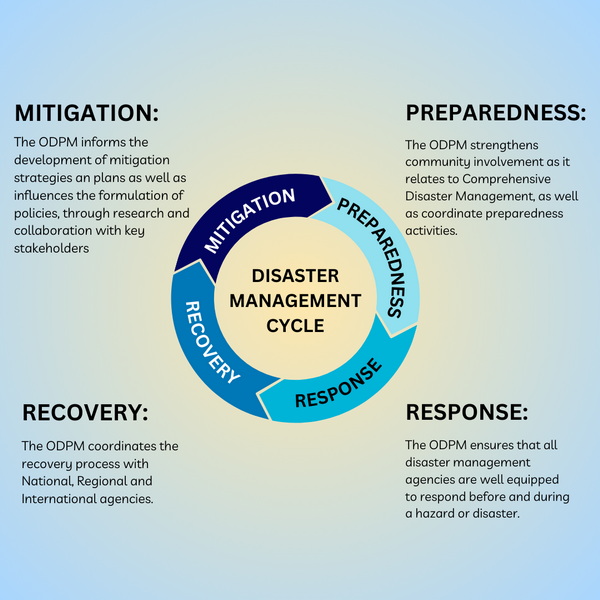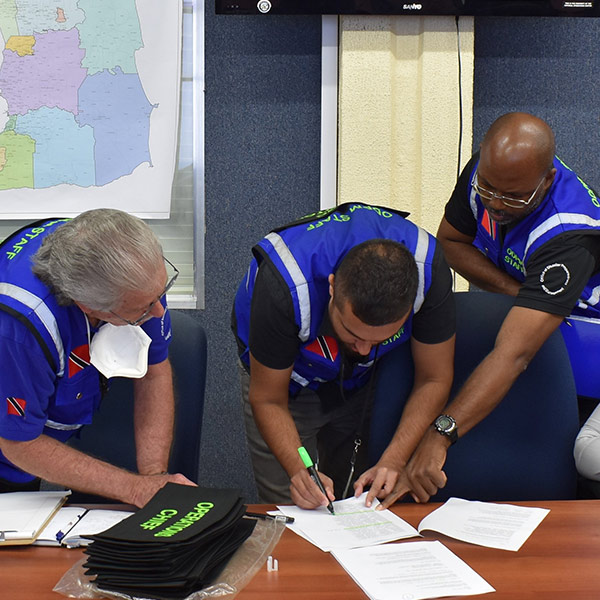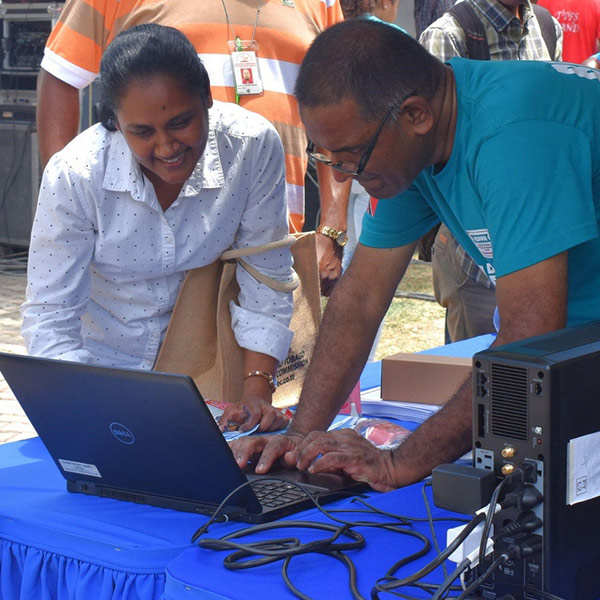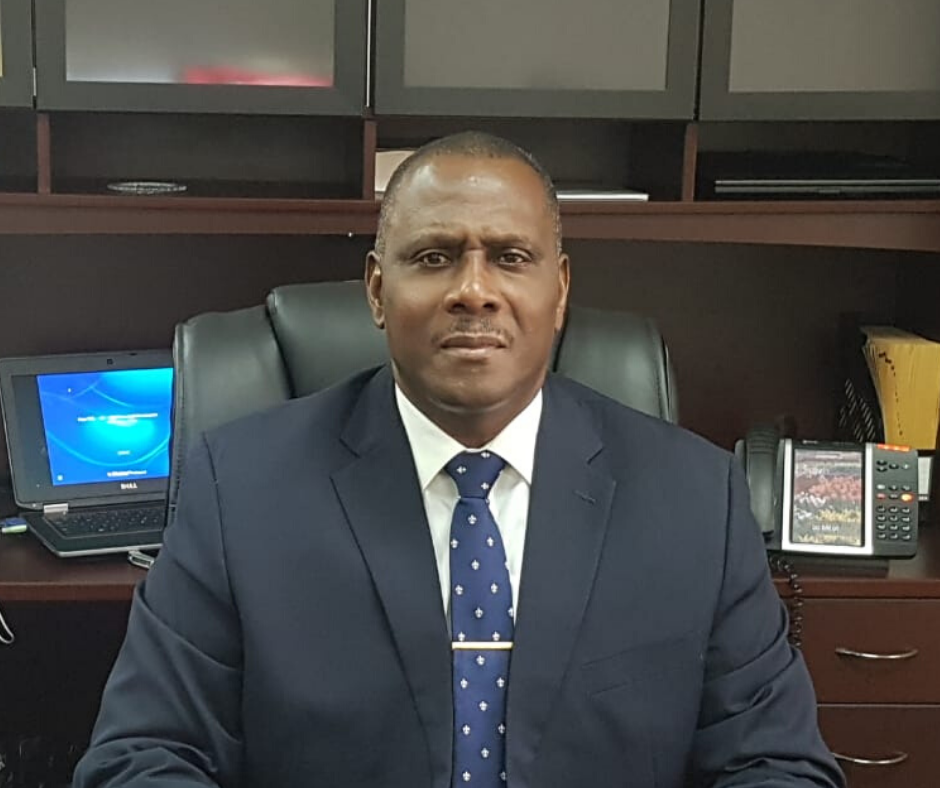About us
The Organization
The Office of Disaster Preparedness and Management (ODPM) was established by Cabinet in January 2005 as the National Disaster Office responsible for managing all aspects of the disaster management cycle which includes mitigation, preparedness, response and recovery. The function of the ODPM is not limited to coordinating efficient response when needed, but also includes proactive, pre-emptive activities geared towards developing a more informed, resilient public.
While the ODPM is the overarching body with connections to all disaster related agencies and entities operating within the borders of Trinidad and Tobago, its work also extends to the Caribbean region as the Sub Regional focal point for the southern sub-region countries inclusive of Grenada, Guyana and Suriname. In this capacity, the ODPM monitors and coordinates responses to hazard impact in these regions.
By its very mandate the ODPM is committed to formulating an all‐hazard approach to emergency/disaster management through close alignment with the Comprehensive Disaster Management (CDM) cycle. A key function of the agency is to act as the primary liaison for stakeholders in DRM in the country.
The main stakeholders are the Ministry of Rural Development and Local Government, the Trinidad and Tobago Defense Force (TTDF), the Trinidad and Tobago Police Service (TTPS), the Trinidad and Tobago Fire Service (TTFS) and the Trinidad and Tobago Meteorological Service (TTMS) just to name a few. The relationships forged through daily and weekly interactions with stakeholders are critical to the successful implementation and facilitation of National DRM practices and protocols.

Vision and Mission
Vision Statement
To become the premier regional Disaster Risk Management Organization.
Mission Statement
To build national Disaster Risk Management (DRM) and Climate Change Adaptation (CCA) capabilities with our partners and coordinate response and recovery operations in order to protect the people, environment and economy and ensure a disaster-resilient nation.
Message From the Chief Executive Officer of the ODPM
On behalf of the Management and Staff of the ODPM, let me warmly welcome everyone to our official website. As CEO, I wholeheartedly believe that through this website many of our citizens and visitors would benefit from learning about the Comprehensive Disaster Management (CDM) cycle as well as the national response to disasters. As a nation we face ongoing challenges with multiple hazards that affect many of our families, communities and businesses. For this reason, the ODPM continues to work with its strategic partners to strengthen Trinidad and Tobago’s disaster resilience. Through this website, it is our hope everyone will learn about and be better prepared for disasters. We also want the national community to understand the core role and function of the ODPM as well as the role of key agencies that partner with the ODPM during times of national disasters.
Our world continues to feel the effects of climate change and for this very reason we at the ODPM continue to drive strategic initiatives that would ensure our nation’s resilience is strengthened against various hazard events. The ODPM continues to adopt an All of Society approach to strengthening disaster resilience and continues to work with local, regional and international partners, utilising global best practices in DRR to strengthen the capacities of first responders and other agencies.
Importantly, before a disaster strikes, we want citizens and visitors to be well informed, educated and better prepared for disasters. We encourage members of the public to continue to visit our website and enjoy the informative learning opportunities presented. Some of which include understanding the various hazards that can impact our nation, latest news and advisories on disaster management and current projects undertaken by the ODPM and its stakeholders. Of critical importance to the ODPM is engaging members of the public to become volunteers and contribute their much needed skills and talents. As you navigate through the ODPM’s website we encourage everyone to learn, share, participate and partner with us to ensure a better prepared and more resilient Trinidad and Tobago.
The National and Regional Disaster Management System.
In executing its mandate, the ODPM is strategically aligned to the Sendai Framework for Disaster Risk Reduction (DRR) 2015-2030; the Regional Comprehensive Disaster Management (CDM) Strategy and Programming Framework 2014 – 2024 and the Comprehensive Disaster Management Policy Framework.
In January 2020, the Government of the Republic of Trinidad and Tobago adopted the Sendai Framework. As a result of this move, the ODPM under the Ministry of National Security has been designated the operational and implementing agency for the Framework, which provides the necessary elements for a Whole of Society approach towards DRR.
The ODPM remains committed to formulating an all‐hazard approach to Disaster Management through close alignment with the CDM cycle. As part of its coordinating capability, this Office is the primary liaison for stakeholders in DRM in the country. The main stakeholders are the Ministry of Rural Development and Local Government, the Trinidad and Tobago Defense Force (TTDF), the Trinidad and Tobago Police Service (TTPS), the Trinidad and Tobago Fire Service (TTFS) and the Trinidad and Tobago Meteorological Service (TTMS) just to name a few.


THE NATIONAL RESPONSE FRAMEWORK:
The ODPM uses the National Response Framework to guide its level of action and response towards an event and works with other responding agencies and municipal corporations island-wide. As such this Office continues to engage with local, regional and international stakeholders in the field of Disaster Management and Disaster Risk Reduction, to promote and build a safer and more resilient nation. This universally accepted framework provides a unified approach that enables response and support agencies to successfully manage the smallest incident to the largest catastrophe. The NRF is a three levelled system of response that guides the way a hazard incident may be approached.
LEVEL 1 RESPONSE:
Once the hazard is localised, that is, it affects only one municipal corporation or limited areas within Tobago, the municipal corporations of the Ministry of Rural Development and Local Government (MoRDLG) or the Tobago Emergency Management Agency (TEMA) respectively, utilise their resources to respond to the situation. MoRDLG may utilise an all of corporation approach to pool resources from unaffected corporations in order to assist the affected community. The ODPM in its monitoring role would remain prepared and ready to provide immediate support upon request by the first responders.
LEVEL 2 RESPONSE:
If the Hazard is not localised but has instead impacted two or more municipal corporations and the resources of the MoRDLG or TEMA are exhausted, the National Emergency Operations Centre (NEOC) is partially activated to coordinate the response and recovery efforts required; this represents a Level 2 activation. At this level, first responders are assisted by Emergency Support Functionaries (ESFs) who are representatives from various agencies and ministries.
LEVEL 3 RESPONSE:
Should the national resource become overwhelmed in a calamitous event affecting a large geographical area, the NEOC would be fully activated at a Level 3 Activation.
This would ensure:
- The NEOC is fully staffed on a 24/7 basis and ready to meet the needs of victims and local and international responders.
- Resources are efficiently coordinated to address impacts, data gathering and information sharing, strengthen communication among agencies and manage physical and financial resources.
The NRF therefore ensures cohesiveness and guides the level of response and the actions to be carried out by the early warning agencies, the Level 1 responders, the ODPM and other response and supporting agencies.
Disasters are everyone’s business. It is essential that all citizens and businesses understand the systems which guide their national agencies. Together, we can reduce risk and build Trinidad and Tobago’s resilience to disasters.
1800+
People
Number of people who signed up for PANS
50.000+
People
Number of people that were sensitized
Outreach
Drill/ Outreaches/ Webinars done for the year
Prepare, Protect, and Preserve -Take action now and prioritize disaster preparedness to protect yourself, your loved ones, and your community from the unpredictable challenges that lie ahead.
Organisational Structure
The structure of the ODPM is based on the country’s unique national requirements and its work to address all issues related to the Comprehensive Disaster Management Cycle. It is also informed by research on Disaster Risk Reduction studies and issues in Disaster Management. In an effort to fulfil its mandate in the most efficient and effective way, the ODPM is divided into 5 units/sections best matched to this work of CDM:
- Mitigation, Planning and Research Unit- advocates policy planning, GIS analysis, mitigation planning, implementation of mitigation strategies, data collection, dissemination of information, research and critical facilities protection.
- Preparedness and Response Unit- is responsible for the coordination of First Responder agencies, facilitation of training and capacity building, strengthening programmes for the first responder agencies and the development of Response Plans.
- Public Information and Education Community Outreach Unit- has oversight for public education/awareness initiatives, public relations, information dissemination, media relations, community outreach programmes and volunteerism.
- Administrative Support and Finance Unit- is responsible for business services, human resources, finance and accounting and information communications technology.
- Project Management Unit- assists the ODPM’s strategic unit in project monitoring, tracking and reporting to internal or external agencies.


Preparedness and Response Unit
- is responsible for the coordination of First Responder agencies, facilitation of training and capacity building, strengthening programmes for the first responder agencies and the development of Response Plans.

Mitigation, Planning and Research Unit
- advocates policy planning, GIS analysis, mitigation planning, implementation of mitigation strategies, data collection, dissemination of information, research and critical facilities protection.

Public Information and Education Community Outreach Unit
- has oversight for public education/awareness initiatives, public relations, information dissemination, media relations, community outreach programmes and volunteerism.

Administrative Support and Finance Unit
- is responsible for business services, human resources, finance and accounting and information communications technology.




